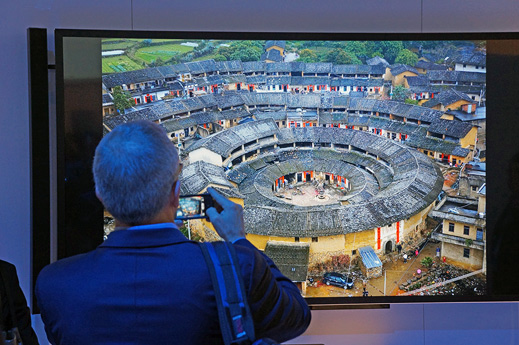Quantum Dots Get Commercial Debut in More Colorful Sony TVs
Sony is using nanoscale particles called quantum dots to significantly improve the color of some of its high-end Bravia televisions. It showed off the technology, which increases the range of colors that an LCD television can display by about 50 percent, at the Consumer Electronics Show in Las Vegas this week. This marks the first time that quantum dots—which for a long time have fascinated researchers because of their unusual electronic and optical properties—have been used in a mass-produced consumer electronics product.

Quantum dots emit very specific wavelengths of light. And the precise colors they emit can be tuned by changing their size. Sony is incorporating technology from QD Vision, which has been working to commercialize advances made at MIT over a decade ago. Originally, the company aimed to make quantum dot displays that are similar to OLED displays—the quantum dots would form the pixels of the display, and would be turned on and off by applying electrical current via a transistor. Although QD Vision has developed prototypes of these displays, they’ve been difficult to make reliably in large sizes (see “This Display Is a Quantum Leap”).
The product that’s finally coming to market is far different. Sony’s new television is a modified LCD TV. In LCD televisions, each pixel is illuminated from behind by a white backlight, and different colors are created by changing the amount of light allowed to pass through three different filters—one red, one green, and one blue. LCDs originally used fluorescent bulbs as the backlight, but now most use LEDs (marketers call these products LED LCDs). QD Vision uses quantum dots to enhance the LED backlight.
While sleeker and sharper than their bulky CRT predecessors, LCD displays can’t produce the full range of color that CRTs could. The problem is the filters. They’re not very selective—the red filter might allow some of the orange part of the spectrum through, for example. And when the impure reds and greens mix, they produce washed-out colors.
“Any blade of grass has colors you can’t see on your display,” says Seth Coe-Sullivan, chief technology officer of QD Vision. His company takes advantage of the optical properties of quantum dots to allow LCDs to display the same range of colors as the best old CRT displays—and close to the range of colors produced by expensive OLED displays (see “Would You Pay $8,000 for a TV?”). (Other qualities, such as contrast, won’t be quite as good as OLEDs.)
QD Vision’s technology eliminates the white backlight. It starts with a conventional blue LED, which produces pure blue light. But that blue light also stimulates two kinds of quantum dots that emit pure green and pure red. With this approach, the only wavelength that passes through the red filter is the pure red emitted by the red quantum dots.
Sony hasn’t announced prices for the new displays yet. But Coe-Sullivan says they will be priced in the range of current LCD TVs, not OLED televisions, which are far more expensive. The models that use QD Vision’s technology will carry the brand “Triluminos.”
The new technology is a hit with some industry watchers (one publication named the new Sony KD-65X9000A, one of the TVs to feature the quantum dots, “Best in Show” at CES). Sony is pairing the quantum dot backlighting with other innovations, such as 3-D and and ultra-high 4K resolution, which it hopes will boost sales. Sales of TVs have been flagging.
Other quantum dot displays are in the works. For example, last year Nanosys announced it would have a quantum dot backlight product in a notebook in 2013, but it hasn’t disclosed the specific product (see “Quantum Dots Give Notebooks a New Glow”).
Keep Reading
Most Popular
Large language models can do jaw-dropping things. But nobody knows exactly why.
And that's a problem. Figuring it out is one of the biggest scientific puzzles of our time and a crucial step towards controlling more powerful future models.
How scientists traced a mysterious covid case back to six toilets
When wastewater surveillance turns into a hunt for a single infected individual, the ethics get tricky.
The problem with plug-in hybrids? Their drivers.
Plug-in hybrids are often sold as a transition to EVs, but new data from Europe shows we’re still underestimating the emissions they produce.
Google DeepMind’s new generative model makes Super Mario–like games from scratch
Genie learns how to control games by watching hours and hours of video. It could help train next-gen robots too.
Stay connected
Get the latest updates from
MIT Technology Review
Discover special offers, top stories, upcoming events, and more.